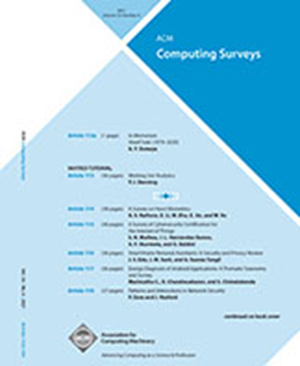Secure Robotics: Navigating Challenges at the Nexus of Safety, Trust, and Cybersecurity in Cyber-Physical Systems
IF 23.8
1区 计算机科学
Q1 COMPUTER SCIENCE, THEORY & METHODS
引用次数: 0
Abstract
The growing pervasiveness of robotic and embodied artificial intelligence systems in daily life and within cyber-physical environments highlights a complex web of challenges at the intersection of robotic safety, human-to-robot trust, and cybersecurity. This article explores these challenges by emphasising the crucial role of security in establishing and maintaining trust between humans and robots, which is integral to successfully adopting and operating these systems in human environments. Safety considerations include mitigating the risks of physical harm and environmental damage due to robotic malfunctions or cyberattacks, particularly in autonomous robots requiring high built-in safety measures. From a cybersecurity perspective, these systems face unique challenges due to their complex, interconnected software and hardware components that necessitate robust protection against data breaches to ensure secure data communication. Additionally, the dynamic interaction of these systems with the physical environment adds a layer of complexity, which makes the safety, security, and reliability of these interactions a vital component of the overall security strategy. This paper reviews these areas within the cyber-physical systems paradigm by focusing on engineering fail-safe mechanisms, the importance of trust and ethical responsibility in human-robot interactions, and the need for resilient cybersecurity measures. At this nexus, a table of crossover challenges illustrates the intricacy of integrating safety, trust, and security in robotic systems. This paper introduces “secure robotics” as a new paradigm to address these collective challenges with a novel model to provide a structured methodology for evaluating and enhancing robotic system performance that symbolises the convergence of theoretical constructs with empirical analysis. By defining secure robotics, the paper establishes a framework for advancing robotics in the cyber-physical era in alignment with current technological trends while anticipating future developments. This framework positions secure robotics as a key contributor to the evolution of cyber-physical systems.求助全文
约1分钟内获得全文
求助全文
来源期刊

ACM Computing Surveys
工程技术-计算机:理论方法
CiteScore
33.20
自引率
0.60%
发文量
372
审稿时长
12 months
期刊介绍:
ACM Computing Surveys is an academic journal that focuses on publishing surveys and tutorials on various areas of computing research and practice. The journal aims to provide comprehensive and easily understandable articles that guide readers through the literature and help them understand topics outside their specialties. In terms of impact, CSUR has a high reputation with a 2022 Impact Factor of 16.6. It is ranked 3rd out of 111 journals in the field of Computer Science Theory & Methods.
ACM Computing Surveys is indexed and abstracted in various services, including AI2 Semantic Scholar, Baidu, Clarivate/ISI: JCR, CNKI, DeepDyve, DTU, EBSCO: EDS/HOST, and IET Inspec, among others.
 求助内容:
求助内容: 应助结果提醒方式:
应助结果提醒方式:


